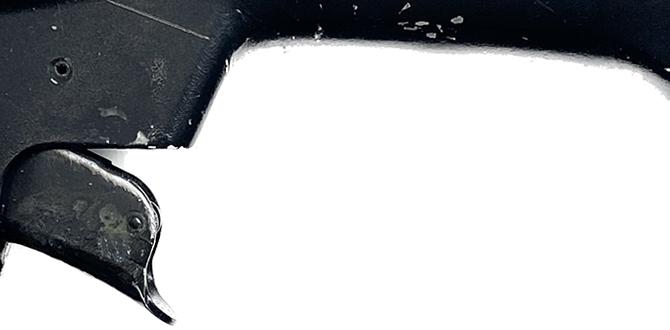Quick Summary: A misfiring cordless nail gun is usually due to a jammed nail, low battery, dirty air filter, or worn-out O-rings. This guide offers simple, step-by-step fixes for common issues, helping you get your tool working reliably. Master these easy troubleshooting steps to keep your projects moving smoothly.
Hey there, DIYers and woodworking fans! Jack Shaffer here from Nailerguy, and if you’ve ever been in the middle of a project, ready to drive a nail home, only to have your trusty cordless nail gun sputter and refuse to fire, you know that sinking feeling.
It’s frustrating, I get it. You’ve got momentum, you’re excited about your build, and suddenly your tool decides to take a break. But don’t worry! Most of the time, a misfiring cordless nail gun isn’t a sign of a major problem. It’s usually something simple that you can fix yourself with a little patience and a few basic steps.
In this guide, we’ll walk through the most common reasons your cordless nail gun might be misfiring. We’ll cover everything from jammed nails to power issues, providing clear, easy-to-follow solutions. By the end, you’ll feel confident tackling these issues and get back to building in no time. Let’s dive in and get your nailer firing again!
Table of Contents
Why Isn’t My Cordless Nail Gun Firing? Common Culprits
Cordless nail guns are fantastic for convenience, no air hoses or compressors needed! But like any tool, they can sometimes throw a curveball. A misfire means you’re pressing the trigger, and instead of a satisfying thwack, you get… nothing. Or maybe a weak click. Don’t panic!
The good news is that the most frequent causes are straightforward. Let’s break down the usual suspects:
- Nail Jams: This is probably the most common reason for any nail gun to stop working, cordless or otherwise.
- Power Issues: A depleted battery or a faulty connection can easily lead to a misfire.
- Dirty or Clogged Components: Just like anything mechanical, your nail gun needs to be clean to work its best.
- Internal Wear and Tear: Over time, parts can wear out, affecting performance.
- Safety Features Engaged: Sometimes, the gun is working perfectly, but a safety feature is preventing it from firing.
We’ll tackle each of these one by one, so you can pinpoint the problem and get your nail gun back in action.
Step-by-Step Guide: How to Fix a Misfiring Cordless Nail Gun
Alright, let’s get your nail gun sorted. We’ll start with the easiest things first. Remember, safety is always key. Always disconnect the battery before you start poking around inside your tool!
Step 1: Check for Nail Jams (The Most Likely Suspect!)
A jammed nail gun is like a car with a flat tire – it’s not going anywhere until it’s fixed. Here’s how to clear a jam:
- Safety First: Remove the Battery! This is crucial. You don’t want the gun firing unexpectedly while you’re trying to dislodge something.
- Examine the Nosepiece: Look carefully at the front of the nail gun, where the nails come out. Can you see a nail bent or stuck in the channel? Sometimes, a nail will get driven partially and then get stuck.
- Gentle De-jamming: If you see a nail, try to carefully pull it out with needle-nose pliers. Wiggle it gently. Avoid forceful prying that could damage the tool.
- Clear the Magazine: If the jam is inside the magazine (the part that holds the nails), you might need to slide the magazine sleeve open and carefully remove the obstruction. Sometimes, the magazine needs to be emptied and reloaded carefully.
- Inspect the Driver Blade: In some cases, the driver blade (the part that actually strikes and drives the nail) might be bent or damaged, which can cause jams. If you suspect this, it might require professional repair.
- Test Fire (With Safety ON): Once you think the jam is clear, reinsert the battery. Point the nosepiece at a scrap piece of wood (never at yourself or anyone else!), and try firing a nail. If it works, great! If not, let’s move to the next steps.
Dealing with nail jams is almost a rite of passage for nail gun users. A little patience here can save you. For more on nail gun maintenance, you can check out resources from the Occupational Safety and Health Administration (OSHA) on the safe use of powered nailers.
Step 2: Check and Charge Your Battery
Modern cordless nail guns are battery-powered, and just like your phone, they need a good charge to operate. A common mistake is assuming the battery has enough juice when it doesn’t.
- Is the Battery Fully Charged? Many batteries have indicator lights. Make sure they show a full charge.
- Proper Battery Installation: Ensure the battery is clicked firmly into place. A loose battery won’t provide consistent power.
- Check Battery Contacts: Look at the metal contacts on both the battery and the nail gun. Are they clean? Sometimes, dust or debris can interfere with the electrical connection. Gently clean them with a dry cloth or a pencil eraser.
- Try a Different Battery (If Available): If you have a spare battery, try using that. This helps determine if the issue is with the battery itself.
- Battery Health: Older batteries can lose their capacity or fail completely. If your battery is several years old and you’re noticing performance issues across the board (not just misfires), it might be time for a replacement.
A weak battery might not have enough power to fully drive the nail, or even to engage the firing mechanism. It sounds simple, but it’s often overlooked!
Step 3: Inspect and Clean the Air Filter (For Gas/Air Models)
While most “cordless” nail guns today mean battery-powered, some cordless models still use a small fuel cell (like for gas and air assist) or have internal air components. If your model uses a compressor or has an air intake, a clogged filter can restrict airflow.
- Locate the Air Filter: Consult your nail gun’s manual to find the air filter. It’s often a small, cylindrical element near an air intake port.
- Remove the Filter: Carefully twist or pull the filter out according to your manual’s instructions.
- Inspect for Debris: Is the filter clogged with sawdust, dirt, or oil? A dirty filter can severely impact how efficiently the tool operates, potentially leading to misfires or weaker nail drives.
- Clean or Replace: Most filters can be cleaned by tapping them gently to remove loose debris or blowing them out with compressed air (if you have access to one). If the filter is heavily soiled or damaged, it’s best to replace it. Many manufacturers offer replacement filters.
- Reinstall Correctly: Make sure the filter is reinstalled securely.
- Lubrication: Some nail guns require periodic lubrication in the drive channel. Check your manual. Too little lubricant can cause parts to stick.
- Debris in the Channel: Small wood shavings or debris can get lodged in the drive channel, preventing the driver blade from moving freely.
- Actuator Pin Issues: If the actuator pin is stuck down, or if it’s not being fully depressed when you press the nosepiece against the material, the gun won’t fire. Sometimes, this pin can get jammed.
- Cleaning: With the battery removed, use a clean cloth to wipe down the drive channel. You can use a small brush or even a wooden skewer (carefully!) to dislodge any debris stuck deep within.
- Actuator Pin Freedom: Gently press the actuator pin with a pen or a similar blunt object. It should retract smoothly and spring back. If it’s sluggish or stuck, try applying a small amount of lubricant recommended by the manufacturer.
- Identify Seal Locations: Your tool’s manual will indicate where key seals and O-rings are located. These are often around the piston chamber or air passages.
- Visual Inspection: With the battery removed and if you’ve dismantled any parts (as per your manual), look for cracked, brittle, or flattened O-rings.
- Signs of Leakage: Sometimes, you might hear a faint hiss of escaping air, indicating a faulty seal.
- Replacement: If you identify damaged seals, you’ll need to order replacements specific to your model. This can sometimes be a more involved repair, and for beginners, it might be wiser to seek professional help or refer to detailed repair videos for your specific tool model.
- Sequential vs. Contact Fire Mode: Some nailers have selectable modes. Ensure you’re in the mode you need (e.g., contact fire for quick nailing, sequential for precise placement). If you’re trying to fire rapidly in sequential mode without lifting the nose, it won’t fire again until the nose touches your work.
- Rafter Hook Interference: Ensure any hanging hooks or belt clips aren’t accidentally engaging the trigger or safety contact.
- Nosepiece Safety Contact: The contact trip mechanism (the little lever at the nose) needs to be pressed firmly against the work surface for the gun to fire. Make sure it’s not damaged or obstructed.
- Depth of Drive Adjustment: While not a misfire cause, if the depth of drive is set too high against a very hard surface, it might appear like a misfire because the nail isn’t fully driven.
- Consult Your Manual’s Troubleshooting Section: Don’t underestimate the documentation that came with your tool! It often has model-specific advice.
- Contact the Manufacturer: If your tool is still under warranty, reaching out to the manufacturer’s customer support is your best bet. They can guide you through advanced troubleshooting or arrange for repairs.
- Professional Tool Repair: For out-of-warranty tools, a reputable tool repair shop can diagnose and fix more complex issues.
- Consider Replacement: If your nail gun is old, heavily used, or requires expensive repairs, it might be more cost-effective to invest in a new one. Modern cordless nail guns have improved battery technology and features that might make an upgrade worthwhile.
Clean air is vital for any engine or pneumatic system to function correctly. This step ensures your nail gun receives the air it needs.
Step 4: Check the Drive Channel and Actuator Pin
The drive channel is the pathway the driver blade travels down to hit the nail. The actuator pin is what the nosepiece bumps against to retract the driver blade and prepare for firing.
A smooth-moving driver blade is essential for a clean nail drive. Any obstruction here will cause problems.
Step 5: Look for Worn O-Rings or Seals
Many cordless nail guns, especially those with pneumatic assist or gas cartridges, rely on O-rings and seals to maintain air pressure and proper function. Over time, these can wear out or become brittle.
Worn seals mean loss of air pressure, which directly affects the force with which the nail is driven, and can lead to misfires or incomplete drives. Resources like tool repair forums or manufacturer websites can be invaluable for finding specific parts and instructions.
Step 6: Check Safety Features
Nail guns have safety mechanisms to prevent accidental firing. Sometimes, these can be the reason your gun isn’t firing, even if everything else seems fine.
It sounds obvious, but double-checking that the safety features are correctly disengaged (when you intend to fire) is a fundamental troubleshooting step.
Step 7: Reset the Tool (If Applicable)
Some electronic nail guns have a reset function, similar to a computer needing a reboot. If your tool has an electronic display or complex circuitry, consult your manual for a reset procedure.
This usually involves removing the battery, waiting a few minutes, and then reinserting it. This can sometimes clear minor electronic glitches that might be preventing the tool from firing.
Troubleshooting Table: Quick Fixes for Misfires
Here’s a quick reference table to help you diagnose common cordless nail gun misfires:
| Symptom | Possible Cause | Quick Fix |
|---|---|---|
| No Firing / No Sound | Battery Disconnected or Low | Check battery connection, charge or replace battery. |
| No Firing / Faint Click | Nail Jammed | Clear nail jam from nosepiece and magazine. |
| Nail Not Driven Fully / Weak Hammer | Low Battery Power | Charge battery. |
| Nail Not Driven Fully / Weak Hammer | Clogged Air Filter (gas/air models) | Clean or replace air filter. |
| Nail Not Driven Fully / Weak Hammer | Worn Seals / Low Air Pressure | Inspect and replace seals if necessary. |
| No Firing / Trigger Feels Loose | Safety Feature Engaged | Ensure contact nosepiece is pressed, check trigger lockout. |
| Intermittent Misfires / Jamming | Debris in Drive Channel | Clean drive channel and actuator pin. |
When to Call a Professional or Consider Replacement
Most of the time, these simple fixes will get your cordless nail gun firing like new. However, there are times when the problem might be more serious.
If you’ve gone through all the common troubleshooting steps and your nail gun still isn’t firing correctly, it’s time to consider the next steps:
Don’t get discouraged if you can’t fix it yourself. Tools can be complicated, and sometimes, professional help is the most efficient solution.
Frequently Asked Questions (FAQ)
Here are some common questions beginner woodworkers have about misfiring cordless nail guns.
Q1: How do I safely clear a jammed nail gun?
Always remove the battery first. Then, try to gently pull out the jammed nail with pliers. If it’s stuck further in, you may need to carefully slide open the magazine and clear the obstruction. Avoid excessive force.
Q2: My nail gun is firing, but the nails aren’t going in all the way. What’s wrong?
This is often a power issue. Make sure your battery is fully charged. If it is, check for a clogged air filter (if applicable) or a worn seal that’s causing a loss of air pressure. A bent driver blade can also be a cause.
Q3: Can I use any brand of nails in my cordless nail gun?
No, it’s crucial to use the correct size, collation angle, and type of nails specified by your nail gun’s manufacturer. Using the wrong nails is a primary cause of jams and can damage your tool.
Q4: How often should I lubricate my cordless nail gun?
This depends on the model. Many modern battery-powered nail guns are virtually maintenance-free and don’t require regular user lubrication. Always refer to your specific tool’s manual for recommended maintenance and lubrication schedules.
Q5: Is it normal for my nail gun to make different noises when it’s misfiring?
Yes, the sound can tell you a lot. A faint click might indicate no power reaching the firing mechanism, while a dull thud could mean compression isn’t strong enough to drive the nail. A complete silence might mean a safety lockout is engaged or the battery is dead.
Q6: What should I do if I suspect a damaged driver blade?
A bent or broken driver blade usually requires professional repair or replacement of the part. Trying to force it can cause further damage to your tool. Consult your manual or a repair service.
Conclusion
Dealing with a misfiring cordless nail gun can be an interruption to your woodworking projects, but as you’ve seen, most common issues are quite manageable. By systematically checking for nail jams, ensuring your battery is charged, keeping components clean, and understanding your tool’s safety features, you can troubleshoot and fix many problems yourself.
Remember, patience and careful attention to safety will always guide you. A well-maintained nail gun is a reliable partner for any DIY task, from framing a deck to building intricate furniture. Keep these steps in mind, refer to your tool’s manual when in doubt, and you’ll be well-equipped to keep your projects moving forward without those frustrating pauses.
Happy building, and may your nails always drive true!



